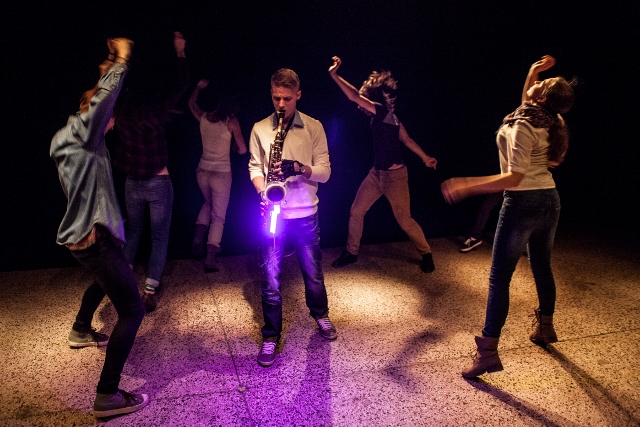 MOVE fest, the festival of contemporary dance, movement theatre and new circus, started on Monday, November 10, 2014. It took place in Ostrava, in the Cooltour cultural centre, which hosted lectures, presentations and discussions for five days. The festival kicked off, and beneath the surface the Silesian metropolis was pulsating with the cultural life and the will to be seen and heard.
Cultural confession
The fact that people enjoyed the festival was also proved by the interest in the Cultural confession formed by the New Network organization. It was built at the Main Railway Station Ostrava on Sunday afternoon. However, the public presentation of this project´s output could not be held on Monday due to the organizer´s illness. Yet, we take it from the final report and we reprint it for you since it is really appealing. The Cultural confession project offers citizens an opportunity to talk about what bothers them or what makes them happy not only as for the cultural life in their town and neighbourhood. The clues that resulted from the outputs help cultural organizers, people involved in cultural life and people in authority to form an overall picture of the cultural situation in the town. Deficiencies, requests for change and feedback to their own activities are included. The principle of the Confession booth is personal communication and subsequent professional work with the obtained data.
The Confession booth serves as an effective tool to enhance cultural life; it contributes to civic awareness, it improves local facilities and it works as a mediator of the discussion and as an activator of life in the town. The primary goal of the Confession booth is to encourage citizens to stop and ponder; the Confession booth is not a means of data accumulation and production of statistics. The meeting with the cultural confessor proceeds in this spirit, i.e. at the individual level. The content of the conversation is not associated with a particular person; the data obtained from the interview are treated anonymously.
MOVE fest, the festival of contemporary dance, movement theatre and new circus, started on Monday, November 10, 2014. It took place in Ostrava, in the Cooltour cultural centre, which hosted lectures, presentations and discussions for five days. The festival kicked off, and beneath the surface the Silesian metropolis was pulsating with the cultural life and the will to be seen and heard.
Cultural confession
The fact that people enjoyed the festival was also proved by the interest in the Cultural confession formed by the New Network organization. It was built at the Main Railway Station Ostrava on Sunday afternoon. However, the public presentation of this project´s output could not be held on Monday due to the organizer´s illness. Yet, we take it from the final report and we reprint it for you since it is really appealing. The Cultural confession project offers citizens an opportunity to talk about what bothers them or what makes them happy not only as for the cultural life in their town and neighbourhood. The clues that resulted from the outputs help cultural organizers, people involved in cultural life and people in authority to form an overall picture of the cultural situation in the town. Deficiencies, requests for change and feedback to their own activities are included. The principle of the Confession booth is personal communication and subsequent professional work with the obtained data.
The Confession booth serves as an effective tool to enhance cultural life; it contributes to civic awareness, it improves local facilities and it works as a mediator of the discussion and as an activator of life in the town. The primary goal of the Confession booth is to encourage citizens to stop and ponder; the Confession booth is not a means of data accumulation and production of statistics. The meeting with the cultural confessor proceeds in this spirit, i.e. at the individual level. The content of the conversation is not associated with a particular person; the data obtained from the interview are treated anonymously.
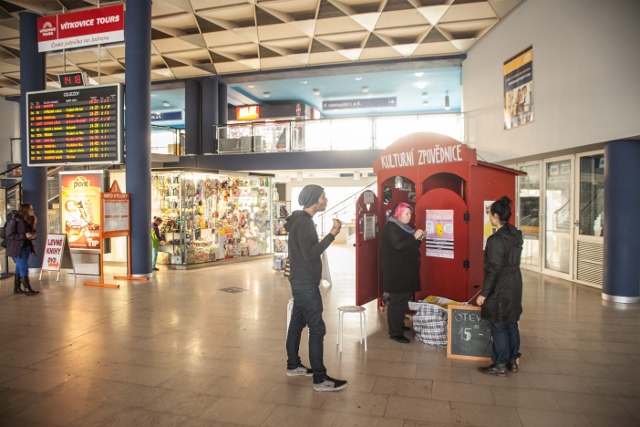 The Confession booth has always benefits, especially for visitors, and that is the main objective of the project - initiation, motivation and a good feeling from the dialogue. The location of the Confession booth at the main station offered an interesting social atmosphere. It was attended not only by citizens of Ostrava, but also by respondents waiting for the train or those who came here to confess, ranging in age from nine to seventy-five years. Confessions took place not only inside the Confession booth, but also in front of it, where sometimes several small debate forums arose. Unlike in other cities where the project took place, the visitors of the Cultural confession had a tendency to talk in a very personal way there. They often talked about their current family or social situation, unemployment or wishes and goals tied to their immediate surroundings. They rather avoided genera
l topics that are considered either media or social clichés (e.g. environment, unemployment, politics), they looked with hope to the new Mayor and city leaders, they mentioned dissatisfaction with the lack of cleaning services in the city and its crime rate. They complained about the gradual depopulation of the city centre, lack of service coverage and centralization of shopping centres (especially Karolina), which are difficult to reach mainly for the elderly. You could feel patriotism from most replies – Ostrava feels like home for local people, including immigrants; visitors from other cities consider the city a cultural and attractive one with a wide variety of opportunities. During the interviews it showed up that the residents know a lot about the culture and that the awareness of all genres is sufficient. Even if the residents feel that the offer is often adapted for tourists and visitors to the city, they do not consider it a problem. Yet, some of them thought that the concept of alternative culture was barely legible – they know where to go, what is organized where, but they often fail to clearly define what kind of offer it is. They knew the Cooltour but they could not say whether it is a gallery, theatre, or dance scene, although they acknowledge its existence. Of course, a large group of people having no interest in culture was found. (Selected and abridged from the final report of the project Nové sítě, by Adriana Světlíková.)
What is it like to be a freelancer or a ballet dancer?
The Confession booth has always benefits, especially for visitors, and that is the main objective of the project - initiation, motivation and a good feeling from the dialogue. The location of the Confession booth at the main station offered an interesting social atmosphere. It was attended not only by citizens of Ostrava, but also by respondents waiting for the train or those who came here to confess, ranging in age from nine to seventy-five years. Confessions took place not only inside the Confession booth, but also in front of it, where sometimes several small debate forums arose. Unlike in other cities where the project took place, the visitors of the Cultural confession had a tendency to talk in a very personal way there. They often talked about their current family or social situation, unemployment or wishes and goals tied to their immediate surroundings. They rather avoided genera
l topics that are considered either media or social clichés (e.g. environment, unemployment, politics), they looked with hope to the new Mayor and city leaders, they mentioned dissatisfaction with the lack of cleaning services in the city and its crime rate. They complained about the gradual depopulation of the city centre, lack of service coverage and centralization of shopping centres (especially Karolina), which are difficult to reach mainly for the elderly. You could feel patriotism from most replies – Ostrava feels like home for local people, including immigrants; visitors from other cities consider the city a cultural and attractive one with a wide variety of opportunities. During the interviews it showed up that the residents know a lot about the culture and that the awareness of all genres is sufficient. Even if the residents feel that the offer is often adapted for tourists and visitors to the city, they do not consider it a problem. Yet, some of them thought that the concept of alternative culture was barely legible – they know where to go, what is organized where, but they often fail to clearly define what kind of offer it is. They knew the Cooltour but they could not say whether it is a gallery, theatre, or dance scene, although they acknowledge its existence. Of course, a large group of people having no interest in culture was found. (Selected and abridged from the final report of the project Nové sítě, by Adriana Světlíková.)
What is it like to be a freelancer or a ballet dancer?
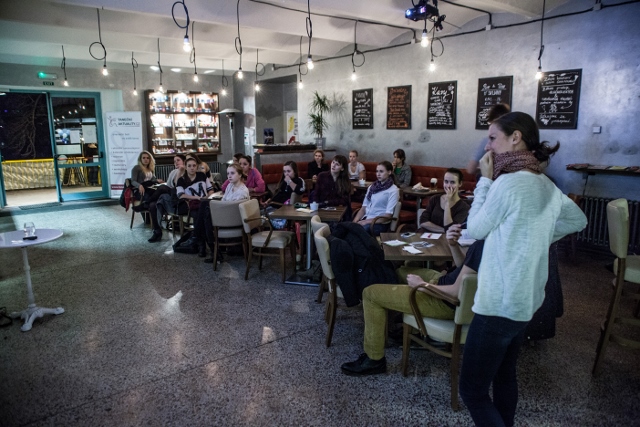 The Programme in Cooltour began with the lecture of Karolina Hejnová, a successful dance producer and cultural manager, Freelancer´s Survival Camp, in which she tried to confront dancers with the reality of production and management work in the cultural environment. To live as a freelancer means first and foremost to be able to control yourself and to be able to effectively realize your artistic ambitions to make your dreams come true. Karolina Hejnová´s theoretical knowledge and practical experience resulted in a lively and informative talk about the need for managerial thinking to enforce any artistic intention, whether at the regional level, or at the national or international one. For dancers, who made the majority of the audience, the biggest benefit was probably the emphasis on the need for self-control and thorough effective planning of activities leading to the set goal. Karolina Hejnová also briefly summarized the basic options of financing independent dance projects and necessary quality of grant applications that ensure success. It is a pity that more time was not devoted on such an interesting topic since the lecturer had a lot to say, and it would be better for visitors to have the occasion to absorb her experience.
While waiting for the evening performance, visitors had the opportunity to listen to interviews with former ballerinas at Miřenka Čechová´s installation “I used to be a ballet dancer in the Cooltour Gallery”. It is a bold project, which through the mouths of five women points out at the artificiality of conservatory dan
ce education, its outdated system, hostile and noneducational environm
The Programme in Cooltour began with the lecture of Karolina Hejnová, a successful dance producer and cultural manager, Freelancer´s Survival Camp, in which she tried to confront dancers with the reality of production and management work in the cultural environment. To live as a freelancer means first and foremost to be able to control yourself and to be able to effectively realize your artistic ambitions to make your dreams come true. Karolina Hejnová´s theoretical knowledge and practical experience resulted in a lively and informative talk about the need for managerial thinking to enforce any artistic intention, whether at the regional level, or at the national or international one. For dancers, who made the majority of the audience, the biggest benefit was probably the emphasis on the need for self-control and thorough effective planning of activities leading to the set goal. Karolina Hejnová also briefly summarized the basic options of financing independent dance projects and necessary quality of grant applications that ensure success. It is a pity that more time was not devoted on such an interesting topic since the lecturer had a lot to say, and it would be better for visitors to have the occasion to absorb her experience.
While waiting for the evening performance, visitors had the opportunity to listen to interviews with former ballerinas at Miřenka Čechová´s installation “I used to be a ballet dancer in the Cooltour Gallery”. It is a bold project, which through the mouths of five women points out at the artificiality of conservatory dan
ce education, its outdated system, hostile and noneducational environm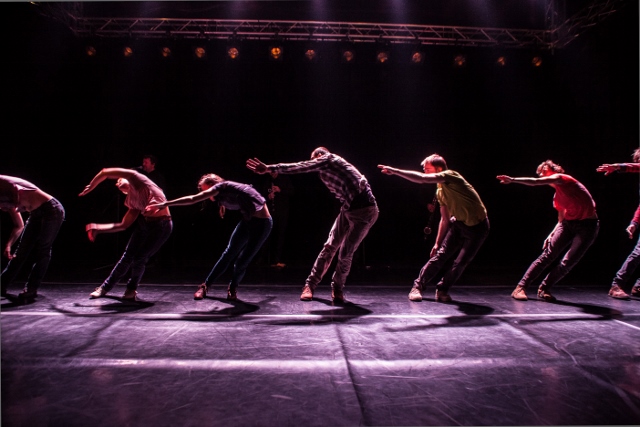 ent, and the ballerina “factory” with a large waste material, which are immature girls spitted out by the institution back to the street with physical and mental consequences . The installation will run throughout the festival, and is definitely worth a visit and thought about how the public can change the evil, which used to be only felt before, but which is now expressed.
Inspiring and liberating VerTeDance and Clarinet Factory
The main star of Monday's programme was the VerTeDance group with the Correction performance, which was awarded as the Inscenation of the year 2004 by the Theatre Newspapers. Seven dancers, breaking limits of physical laws, examine limits of freedom and unfreedom both with humour and regret. Literally chained to the floor, they find out how much joy and sorrow is caused by the impossibility to move with their feet and what new communication and movement patterns arise from the situation. Also, they learn how everyone, particularly while in contact with others, is constantly forced to look for new opportunities within the limits, and how it is sometimes a relief to know your limits in contrast to the abundance of free decision-making.
ent, and the ballerina “factory” with a large waste material, which are immature girls spitted out by the institution back to the street with physical and mental consequences . The installation will run throughout the festival, and is definitely worth a visit and thought about how the public can change the evil, which used to be only felt before, but which is now expressed.
Inspiring and liberating VerTeDance and Clarinet Factory
The main star of Monday's programme was the VerTeDance group with the Correction performance, which was awarded as the Inscenation of the year 2004 by the Theatre Newspapers. Seven dancers, breaking limits of physical laws, examine limits of freedom and unfreedom both with humour and regret. Literally chained to the floor, they find out how much joy and sorrow is caused by the impossibility to move with their feet and what new communication and movement patterns arise from the situation. Also, they learn how everyone, particularly while in contact with others, is constantly forced to look for new opportunities within the limits, and how it is sometimes a relief to know your limits in contrast to the abundance of free decision-making.
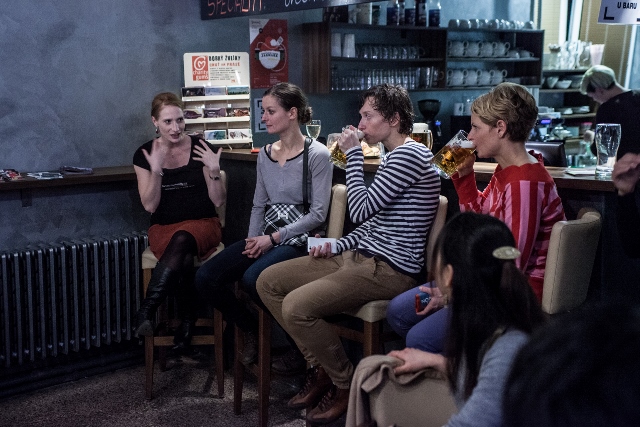 In the discussion after the presentation the audience had the opportunity to take a peek at the creation of the inscenation, at the dancers´ feelings both during rehearsals and performances and to speculate with performers on whether it is a dance production or not if artists do not move during the show.
The first festival evening ended with an informal party to the sounds of the Clarinet Factory, a group which played live music during the performance Correction, and it formed an integral part of the staging. The high attendance on the first day of the festival foreshadows a unique cultural experience that nobody who is going to Ostrava should miss.
In the discussion after the presentation the audience had the opportunity to take a peek at the creation of the inscenation, at the dancers´ feelings both during rehearsals and performances and to speculate with performers on whether it is a dance production or not if artists do not move during the show.
The first festival evening ended with an informal party to the sounds of the Clarinet Factory, a group which played live music during the performance Correction, and it formed an integral part of the staging. The high attendance on the first day of the festival foreshadows a unique cultural experience that nobody who is going to Ostrava should miss.
Written on November, 10, 2014, MOVE fest Ostrava 2014, Cooltour Ostrava.
Translation: Anna Würtherlová



